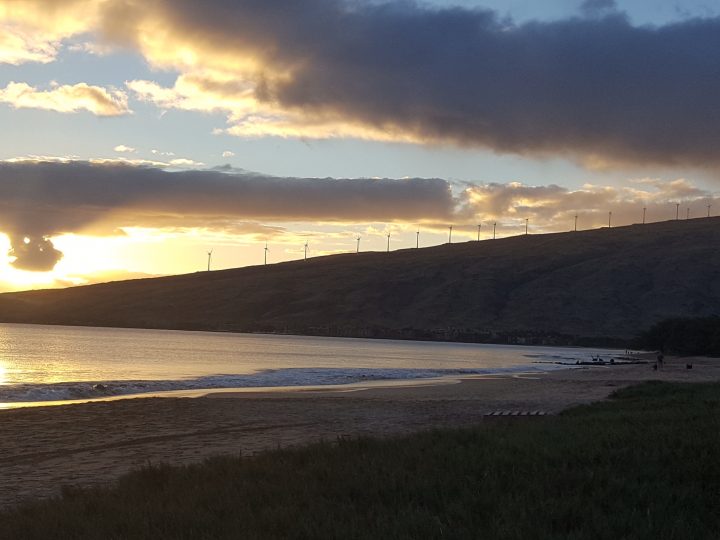By Shanelle Macaraeg
Over the last seven years, Hawai’i’s consumption of fossil fuels has been consistently declining, yet the transportation sector is failing to meet its clean-energy goals.
Hawai’i has more than 1.3 million registered vehicles driving on the road. Only about 5,000 are electric vehicles.
The Blue Planet Foundation, a leading voice in Hawai’i’s quest for 100-percent clean energy, releases annual report cards assessing the state’s progress to eliminating fossil-fuel dependency.
The 2016 report card revealed motor-vehicle fuel sales haven’t been falling. A grade of D+ was given.
“The majority of our fossil fuel goes into transportation, and that’s a challenge that we have to solve, and we currently don’t have a vision for what that future looks like,” said Jeff Mikulina, executive director of the Blue Planet Foundation, in an interview with The Associated Press.
In 2016, Hawaii spent $5.4 billion on imported petroleum, according to the U.S. Energy Information Administration, 62 percent of which was used for transportation. This includes ground transportation (28 percent), commercial aviation (27 percent) and marine transportation (6 percent).
Providing sustainable alternatives for mobility is an area of interest for state lawmakers.
According to a state law enacted in 2009, every parking lot with 100 or more stalls is required to have a charging station for electric vehicles. Last year, the ownership of electric vehicles had increased 26 percent from the previous year.
“It’s easier to manage more renewable energy when we have electric vehicles on the grid that can suck up that excess and hopefully in the future put some energy back on the grid,” Mikulina told the AP.
Energy experts, state officials and associates assembled at the Maui Arts and Cultural Center in March for the annual Maui Energy Conference. Attendees from across the United States gathered to discuss Hawai’i’s developing innovations in renewable, clean-energy technology.
This year, alternative and sustainable transportation goals were a priority for discussion at the conference. Panels discussed incorporating fossil-fuel-consuming industries in Hawai’i’s plans for a clean-energy state. The state’s official goal for 2045 goal is 100-percent renewable energy.
Public awareness can help make a shift to cleaner-energy transportation. In Hawai’i, the amount of people using public transit, walking or biking increases each year.
Conference speakers agreed the key to transforming Hawai’i from a petroleum-dependent state into one that uses cleaner, renewable energy is to change the way transportation is used and create more clean mobility options.
Each day, about 27 million miles are driven in Hawai’i. That equates to about 10.2 billion miles driven a year.
The State of Hawai’i consumes more gas per capita than any other state, and it isn’t due to long-distance drives.

Professor Michael Clay: “What we’ve built isn’t very good.”
Michael Clay for Geography
Photo by Alison Fidel/BYU
February 03, 2011
“The way that we built the islands is not very good,” Dr. Michael Clay said in a panel at the conference. “There’s a real fear of growth on the islands because what we’ve built isn’t very good, and who wants more of it?”
Clay, professor of urban planning at Brigham Young University, studies land use and urban sustainability in built environments.
“If you’re going to make Hawai’i’s future more sustainable, you’re going to have to do something about transportation and, inevitably, something about the way you’re building your city,” he said.
Policy makers are now faced with the challenge of developing infrastructure that betters how the people of Maui move about the island.
Another panelist, Michele McLean, deputy planning director for Maui County, said expanding housing types and creating more options could effectively lead to a better-developed community. The Planning Department processes development permits and drafts long-range plans for the county, including the general plan and community plans.
Housing types on Maui are limited, generally ranging from single-family homes in sprawling neighborhoods to multifamily development in some resort areas. Use of duplex housing – two-story houses that share a common wall – could become a practical way to reduce consumption of fossil fuels by fostering higher-density residential development.
Developing housing in and around existing towns make basic services closer and more accessible. Minimizing the distance between restaurants, shops and community centers reduces the need for residents to use a car and “keeps local dollars in local businesses,” McLean said.
Thoughtful urban-planning strategies can make less of an impact on infrastructure by connecting new developments to existing ones. This not only lessens the need to travel by automobile but also preserves agricultural land and open space.

